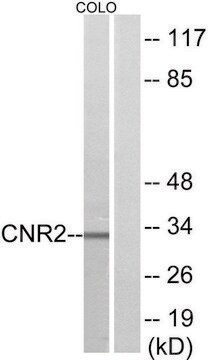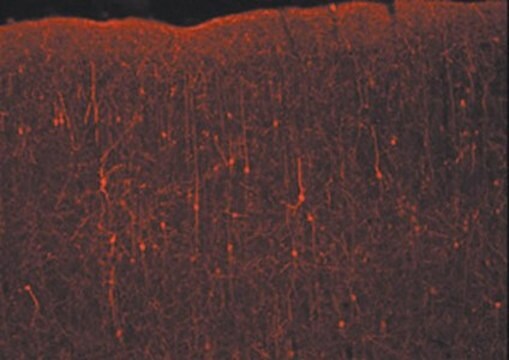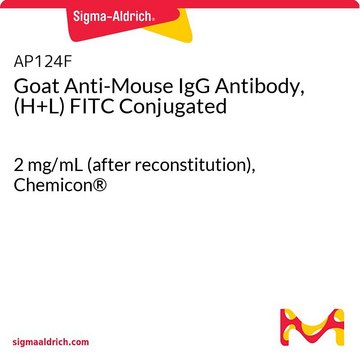C1358
Anti-Cannabinoid Receptor 2 antibody produced in rabbit
affinity isolated antibody, buffered aqueous glycerol solution
Synonym(s):
Anti-CB2
Sign Into View Organizational & Contract Pricing
All Photos(1)
About This Item
Recommended Products
biological source
rabbit
Quality Level
conjugate
unconjugated
antibody form
affinity isolated antibody
antibody product type
primary antibodies
clone
polyclonal
form
buffered aqueous glycerol solution
species reactivity
rat, human
technique(s)
immunocytochemistry: suitable
western blot: suitable
UniProt accession no.
shipped in
wet ice
storage temp.
−20°C
Gene Information
human ... CNR2(1269)
rat ... Cnr2(57302)
Related Categories
Immunogen
fusion protein containing amino acids 1-33 of the human CB2 receptor.
Application
Anti-Cannabinoid Receptor 2 antibodies produced in rabbit is suitable for western blotting at a dilution of 1:250 and used for immunocytochemistry at a dilution of 1:500.
Biochem/physiol Actions
Cannabinoid receptor 2 (CB2R) is a G protein-coupled receptor that belongs to the cannabinoid receptor family and is encoded by CNR2 gene in humans. It is also referred as CB2, CX5 and CB-2. It acts as a major receptor in the endogenous cannabinoid system. It is associated with immunomodulatory, anti-inflammatory effects and acts an important regulator of (T-independent) immune response. CB2R is abundantly expressed in immune tissues.
Physical form
Solution in phosphate buffered saline, containing 1 mg/ml bovine serum albumin, 50% glycerol and 0.05% sodium azide.
Disclaimer
Unless otherwise stated in our catalog or other company documentation accompanying the product(s), our products are intended for research use only and are not to be used for any other purpose, which includes but is not limited to, unauthorized commercial uses, in vitro diagnostic uses, ex vivo or in vivo therapeutic uses or any type of consumption or application to humans or animals.
Not finding the right product?
Try our Product Selector Tool.
Storage Class Code
10 - Combustible liquids
WGK
WGK 1
Flash Point(F)
Not applicable
Flash Point(C)
Not applicable
Choose from one of the most recent versions:
Already Own This Product?
Find documentation for the products that you have recently purchased in the Document Library.
Dongxiao Tong et al.
Journal of molecular neuroscience : MN, 51(2), 454-460 (2013-07-13)
Cannabinoid receptor 2 (CNR2) is a major receptor in the endogenous cannabinoid system. In recent years, many studies have shown that the receptor is closely associated with schizophrenia. This study examined the relationship between CNR2 gene polymorphisms (rs2501432C/T, rs2229579C/T, rs2501401G/A)
Huan Gui et al.
Rheumatology (Oxford, England), 53(5), 802-809 (2014-01-21)
Recent studies have suggested immunomodulatory and anti-inflammatory effects of cannabinoid receptor 2 (CB2R) activation, which shows no psychoactivity. However, it is still unclear whether CB2R is expressed in fibroblast-like synoviocytes (FLS) of RA. In this study we investigated whether CB2R
Sreemanti Basu et al.
Journal of immunology (Baltimore, Md. : 1950), 187(11), 5720-5732 (2011-11-04)
The endocannabinoid system has emerged as an important regulator of immune responses, with the cannabinoid receptor 2 (CB2) and its principle ligand 2-archidonoylglycerol playing a major role. How CB2 regulates B cell functions is not clear, even though they express
S Galiègue et al.
European journal of biochemistry, 232(1), 54-61 (1995-08-15)
Two proteins with seven transmembrane-spanning domains typical of guanosine-nucleotide-binding-protein-coupled receptors have been identified as cannabinoid receptors; the central cannabinoid receptor, CB1, and the peripheral cannabinoid receptor, CB2, initially described in rat brain and spleen, respectively. Here, we report the distribution
Thangesweran Ayakannu et al.
Frontiers in oncology, 9, 430-430 (2019-06-28)
Objective: To identify new biochemical markers for endometrial cancer (EC). Recent evidence suggests that members of the endocannabinoid system (N-acylethanolamines) that bind to and activate receptors that are dysregulated in EC are involved in this tumour's biology. These observations suggest
Our team of scientists has experience in all areas of research including Life Science, Material Science, Chemical Synthesis, Chromatography, Analytical and many others.
Contact Technical Service






![Anti-OCT-4 [POU5F1] Antibody, clone 7F9.2, Alexa Fluor™ 488 conjugate clone 7F9.2, from mouse, ALEXA FLUOR™ 488](/deepweb/assets/sigmaaldrich/product/images/405/633/324511fc-ecc5-4c49-9d9d-8cf25ab28d40/640/324511fc-ecc5-4c49-9d9d-8cf25ab28d40.jpg)
